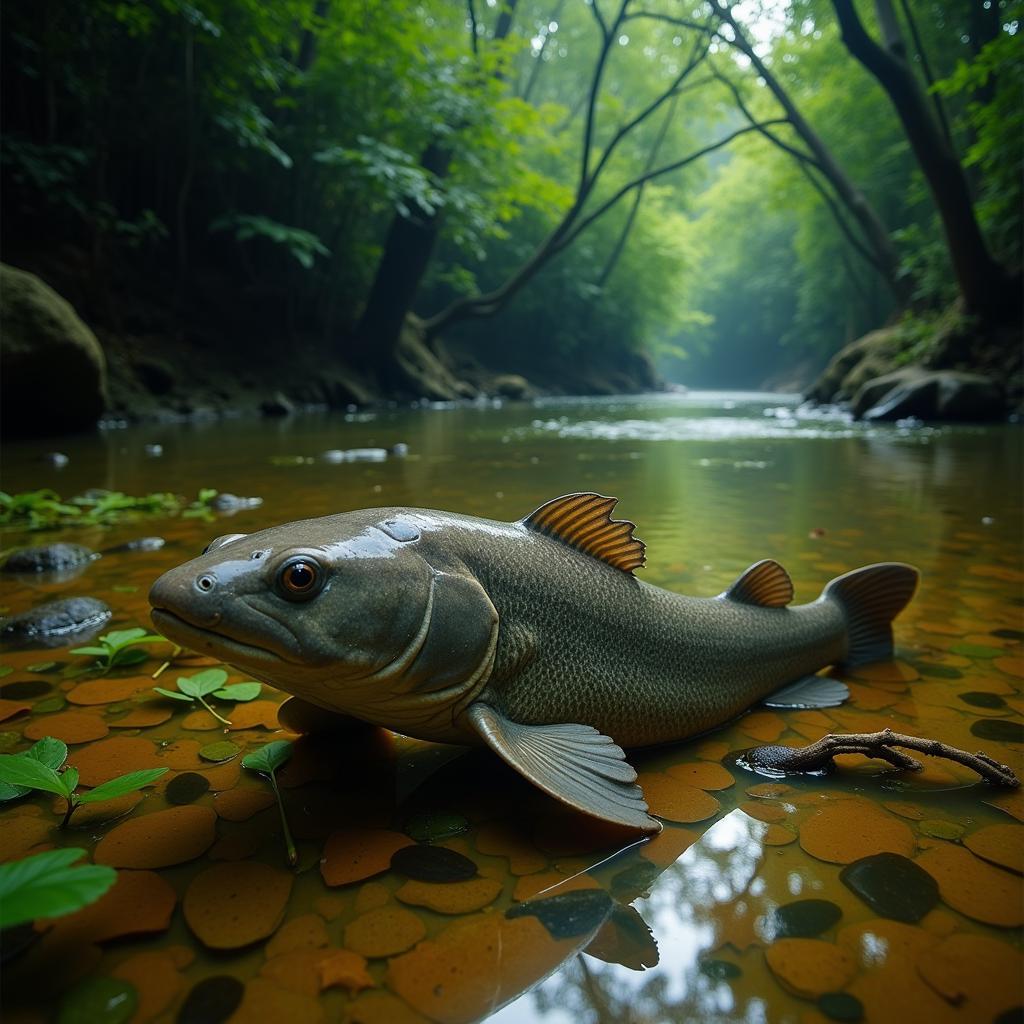African Catfish Scientific Name: A Deep Dive
The African Catfish Scientific Name, Clarias gariepinus, refers to a species known for its hardiness, rapid growth, and air-breathing capabilities. This fascinating fish, native to Africa and the Middle East, has become a significant player in aquaculture worldwide and also a subject of ecological concern in some regions. Let’s explore the various facets of this intriguing species, from its biology and ecological impact to its cultural significance and economic importance.
Understanding Clarias gariepinus: Biology and Characteristics
Clarias gariepinus, also known as the sharptooth catfish, is characterized by its elongated, scaleless body and distinctive whisker-like barbels surrounding its mouth. These barbels act as sensory organs, helping the catfish navigate murky waters and locate food. Their ability to breathe air allows them to survive in oxygen-depleted environments and even travel short distances over land, making them highly adaptable. They are opportunistic feeders, consuming a wide range of prey, including insects, crustaceans, mollusks, and even small fish. This adaptable diet contributes to their rapid growth, making them attractive for aquaculture. You may have even heard of the African catfish found as Salwa Ha Heeb, a topic sparking interest in certain regions.
This ability to thrive in diverse environments makes the Clarias gariepinus a formidable species.
The Ecological Impact of African Catfish
While the African catfish’s adaptability is advantageous for aquaculture, it can also pose ecological challenges. Introduced to non-native environments, Clarias gariepinus can become invasive, outcompeting native species for resources and disrupting established ecosystems. Their voracious appetite and rapid reproduction rate can lead to declines in native fish populations and alter the delicate balance of aquatic ecosystems. Concerns about the African catfish threatening Indian fishing, for example, highlight the potential negative impacts of introducing this species outside its native range. For more information on the potential impacts, you can read about the African catfish farm in Kalakkuruchi.
 African catfish in its natural habitat, showcasing the surrounding environment
African catfish in its natural habitat, showcasing the surrounding environment
Therefore, understanding the potential ecological impact of Clarias gariepinus is crucial for responsible aquaculture practices and conservation efforts.
Clarias gariepinus in Aquaculture and Economy
Despite the ecological concerns, Clarias gariepinus remains an important species in aquaculture. Its fast growth rate, resilience, and ability to tolerate high stocking densities make it a cost-effective option for fish farming. This contributes to food security and economic opportunities in many regions.
What is the scientific classification of African catfish?
The African catfish, Clarias gariepinus, belongs to the class Actinopterygii (ray-finned fishes), order Siluriformes (catfishes), and family Clariidae (airbreathing catfishes). Understanding its taxonomic classification helps us appreciate its evolutionary history and relationship to other fish species. There’s another interesting fish species, the African block head fish, you might find intriguing as well.
African Catfish: Beyond the Scientific Name
Beyond its scientific name and aquaculture importance, the African catfish holds cultural significance in some African communities. It features in traditional diets and plays a role in local customs. Even the unique African knife fish making sound is an example of the rich diversity of aquatic life on the continent.
Conclusion
The African catfish, Clarias gariepinus, is a truly remarkable species. From its unique biological adaptations to its economic and cultural significance, this fish deserves our attention. While its invasiveness poses ecological challenges, responsible aquaculture practices and further research can help us harness its potential while mitigating risks.
FAQ
- What is the lifespan of an African catfish? African catfish can live up to 8 years in the wild and even longer in captivity.
- What is the maximum size of an African catfish? They can grow up to 1.7 meters in length and weigh over 60 kg.
- Are African catfish aggressive? They can be aggressive, especially when competing for food or resources.
- Can African catfish be kept as pets? While possible, their large size and potential for aggression require specialized care.
- What is the nutritional value of African catfish? They are a good source of protein and essential fatty acids.
- How can I identify an African catfish? Look for their elongated body, scaleless skin, and prominent barbels.
- What are the main threats to African catfish populations? Habitat destruction and overfishing are major concerns.
Do you have more questions about African catfish or other aspects of African Life? Explore our other articles on African block head fish or learn more about African catfish found as salwa ha heeb. We also have information on African catfish threatening Indian fishing and african knife fish making sound.
For support, contact us at +255768904061, kaka.mag@gmail.com or visit us in Mbarali DC Mawindi, Kangaga, Tanzania. Our customer service team is available 24/7.




